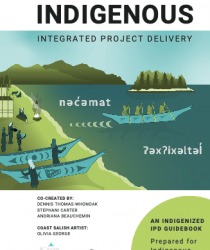Tools
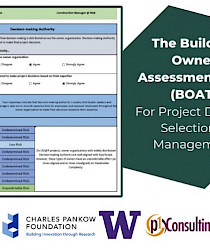
BUILDING OWNER ASSESSMENT TOOL (BOAT) - FOR PROJECT DELIVERY, SELECTION & MANAGEMENT
The Integrated Project Delivery Alliance (IPDA) in partnership with the Charles Pankow Foundation (CPF), the University of Washington College of Built Environments, The American Institute of Architects (AIA), P1 Consulting, and Chandos Construction is pleased to announce a new tool, the Building Owner Assessment Tool (BOAT): Helping You Understand Your Culture and Its Project Delivery Ramifications and is now available for free download and usage.
Visit the Charles Pankow Foundation website https://lnkd.in/gB8pcSr4 for additional information and to download the BOAT tool.
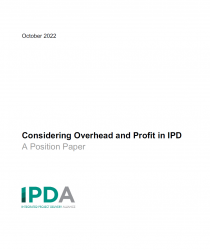
Considering Overhead and Profit in IPD - A Position Paper
A continual area of challenge for companies and teams entering into IPD projects is understanding exactly how overhead and profit are handled. On what are they based? How are they calculated? What’s included or excluded? Designers and constructors calculate them differently--why is that, and how are those differences accommodated? These are just a sampling of the kinds of questions that typically arise.
Written by experienced IPD professionals and shared publicly, the goal of this paper is to improve transparency and provide clarity to the market and the RFP process, helping owners, individuals, companies, and teams navigate the topic by suggesting specific solution paths (and outlining their ramifications), showing examples, and providing sample calculation templates.
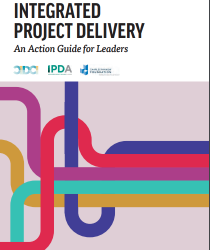
Integrated Project Delivery: An Action Guide for Leaders
This guide, jointly developed by the Center for Innovation in the Design and Construction Industry and the IPDA and sponsored by the Charles Pankow Foundation, is a “how-to” IPD resource for industry. Organized in a roughly chronological fashion following the evolution of a typical IPD project, the Guide provides action steps for owners and teams based on input from over 25 IPD-experienced industry professionals in the US and Canada. The Guide also includes a glossary of IPD terms as well as a broad offering of example templates as points of departure for consideration by teams. A must-read for anyone interested in or working on an IPD project!

Taken from the Integrated Project Delivery: An Action Guide for Leaders (seen above), this document provides thorough definitions of concepts and language commonly used throughout the IPD industry.
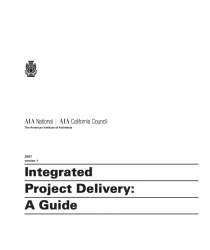
The American Institute of Architect's Guide of IPD
What if we tied the team’s profit to a fixed cost before design began? That’s the key to Integrated Project Delivery. Sutter Health faced a crisis in their business. The cost of delivering hospitals using CM, DB or LS approaches had risen to $2 million per bed. Yet, the business case didn’t make sense past $1.5 million. They challenged their partners to find a better way to build. The challenge was accepted and integrated project delivery was born as a means to eliminate financial waste.
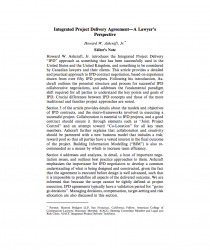
Howard Ashcraft introduces the Integrated Project Delivery ‘‘IPD” approach as something that has been successfully used in the United States and the United Kingdom, and something to be considered by Canadian lawyers and their clients. This article provides a detailed and practical approach to IPD contract negotiation, based on experience drawn from over fifty IPD projects. Following his introduction, As- chraft outlines the potential structure and process for successful IPD collaborative negotiations, and addresses the fundamental paradigm shift required for all parties to understand the key points and goals of IPD. Crucial differences between IPD concepts and those of the more traditional and familiar project approaches are noted.
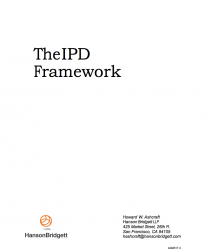
The IPD Framework defines the relationships among the project participants and the processes that guide their actions. It embodies the project goals and creates consequences for success or failure tied to their achievement. It puts control in the hands of the project participants and makes them responsible for total project outcome, not just their individual performance. Correctly designed, it stimulates behaviors that increase creativity, improve productivity, and reduce waste. A strong IPD Framework leads to better outcomes, whether measured in value, aesthetics, sustainability or otherwise.
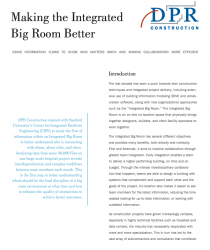
DPR Construction teamed with Stanford University’s Center for Integrated Facilities Engineering (CIFE) to study the flow of information within an Integrated Big Room to better understand who is interacting with whom, about what, and when. Analyzing data from some 30,000 files on one large-scale hospital project reveals interdependencies and complex workflows between team members each month. This is the first step in better understanding whom should be the lead discipline in a big room environment at what time and how to enhance the quality of interactions to achieve better outcomes.
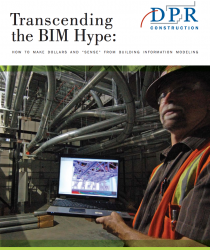
When BIM/VDC first emerged in the commercial construction industry in the 1990s, the consensus was it would revolutionize the architecture, engineering and construction (AEC) industry. It offered the promise of substantial cost and time savings on developing projects. The industry and some clients are now starting to see that happen. Project teams are talking about reduced change orders and no MEP conflicts in the field due to BIM coordination. Still, moving BIM from the realm of theory into real-world practice is challenging.
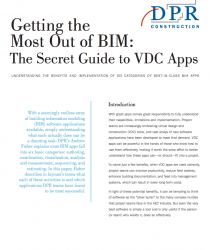
With a seemingly endless array of building information modeling (BIM) software applications available, simply understanding what each actually does can be a daunting task. DPR’s Andrew Fisher explains most BIM apps fall into six basic categories: authoring, coordination, visualization, analysis and measurement, sequencing, and estimating. In this paper, Fisher describes in layman’s terms what each of these activities is and which applications DPR teams have found to be most successful.

On Compensation: Considerations for Teams in a Changing Industry
As the design and construction industry moves toward a transformed future based on highly collaborative project teams and the expanded use of sophisticated technology, the “fit” of traditional compensation models for stakeholders comes into question. These new methodologies and tools not only require different allocations of resources and effort, but also involve changes in the nature of what we do and the time required to accomplish necessary tasks.
